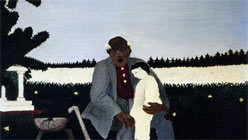Mark Twain’s great American novel The Adventures of Huckleberry Finn, published 125 years ago, is still regarded as a mainstay of the literary canon about race in a post-slavery America. In curating a show inspired by this giant of a novel, the Wattis Institute for Contemporary Arts has taken on something impossible. I mean that in a good and bad way.
The lower galleries are meant to introduce us to Mark Twain, life on the Mississippi in the post-Civil War era, and the novel’s reception. The viewer finds the iconic image of the author (all that electric white hair, pipe hanging from his mouth), a replica of his typewriter, 1885 newspaper reviews of the book, and a screening room showing the original 1920 Huck Finn movie. Perhaps it’s needed, but in truth, all this context feels a little contrived.

“Runaways (detail),” Glenn Ligon, 1993.
Some of the most successful works address the novel directly, taking the slave Jim as their protagonist. Edgar Arceneaux has piled books about science and memory on a desk, half of them in a cardboard box, growing sugar crystals like mold. Titled My Father Jim, the piece honors Jim as a literal and spiritual forefather. Deceptively simple, the work can be understood as a commentary on literacy and disparity in education, a nod to the violent history of sugar farming and slavery, perhaps even a questioning of our relationship to books (isn’t that what the show is about, after all?) as conveyers of knowledge and truth.
This piece is also a harbinger of what is to come: the entire upper gallery is devoted to “an exploration of Jim’s turbulent quest for freedom.” Yinka Shonibare MBE’s installation, titled Jim’s Escape, is composed of a series of small kites on the ceiling and down the stairwell; they are fashioned in classic Shonibare style, out of Dutch-printed “African” dashiki-style cotton. The slave Jim, it appears, can fly away as long as it is on the back of an Anglo.




